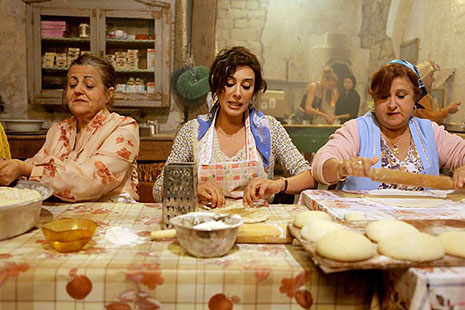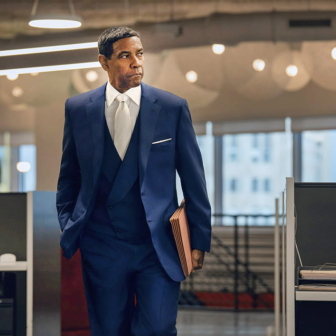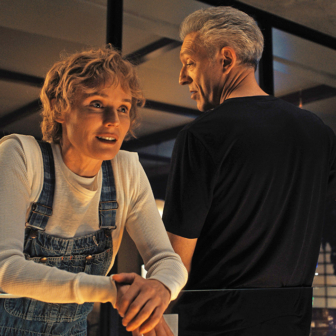HOW much of Woody Allen, I have to wonder, circulates in Russia? Andrey Zvyagintsev’s Elena, which arrives trailing a load of festival awards, evokes memories of Crimes and Misdemeanors; here too, they get away with murder, and the moral complexity is in the directorial viewpoint. But while Allen told a dark story about power and privilege in America, this one is darker. We are invited to think it could happen anywhere, since the account of the family is rigorously classical, and with Elena it’s the family, not the polity, which overhangs. There I disagree with the numerous reviewers who have rushed to interpret the film as an assault on the Putin regime; although the wealthy older man of the story, Vladimir, could perhaps be dubbed an oligarch, the elements of this tale are all there in Dostoevsky and Chekhov.
For the partners in a late-life second marriage, parental bonds are stronger than whatever it is between the two of them. He wants to buy the love of his alienated daughter, while her major object in life is to sustain, if possible rescue, her jobless layabout son and struggling adolescent grandson; her few moments of visible happiness are found with the baby of that family. At those moments Elena smiles; and there’s one other smile, when Vladimir breaks into sexual teasing and leads her off to the bedroom. Most of the time, she’s held-in, dutiful, impassive; doing kitchen duties in the comfortable city apartment she shares with Vladimir, accepting the wife-servant role; then taking up the other role, the grandmother’s, which is plainly more real to her. Nadezhda Markina surely merited her best-actress awards, with heavy bodily movements and a closed face that says nothing and contains everything. Andrey Smirnov’s Vladimir is equally interesting, letting slip his jealousy of the son and grandchildren, looking out from his hospital bed on to incomprehensible emptiness.
In its opening moments the film is about well-appointed living spaces, and a great, bare winter tree outside the apartment’s large windows; then Elena travels by public transport to her son’s messy, crowded flat in a grim suburban wasteland. If the contrast of environments were dominant, the film might be schematic; but it’s complicated, going off in tangents, breaking style to handheld camerawork, pursuing the grandson’s gang on a rampage; stopping, during Elena’s train ride, to look at a horse killed on a rail crossing. We’re not given linkages or reasons; we are given more to think about later on – even more, that is, than the entrapment of Elena, whose understanding of her motherhood puts almost everything outside her control. Behind the banality there is a kind of horror closing in; Philip Glass’s pounding score marks its advance.
After that, Nadine Labaki’s Where Do We Go Now? brings a surge of properly feminist relief. Somewhere in the Middle East, a large group of black-clad women – some with headscarves, many without – comes along a dusty, stony road toward the camera, swaying and chanting. Their movement has been triggered by the arrival of a communal TV set; this brings in the news of strife in the world outside the village, a place not identified. It’s not even clear that we’re in Lebanon, although Labaki has said that her own country’s endless tangling with wars outside and within its borders made this film necessary for her. Watching, we can remember that Lebanon has common borders with both Syria and Israel.
The women have congregated to keep their men out of sectarian clashes between Christian and Muslim within the community, and to stop them from getting into the wars outside. It’s not exactly Lysistrata; the circles of marriage and family hold, the dynamics of the couple persist, but the women maintain a high-spirited, defiant solidarity. They devise a hilarious cooking party in which the cakes are laced with hash to keep the men subdued; they confuse proceedings by engaging in busy multilingual talk, French, English, Arabic; they get a busload of Russian strippers tangled into the community, with grand disregard for customary modesty. Their drive and invention blow stereotypes apart. This is very intelligent political comedy, worth seeing twice.
Tanya Wexler’s Hysteria, by contrast, is intelligent farce, and once will do, but it’s worth your time and ticket. Sex toys have probably been around as long as sex, while the earliest novels tell us that there was never anything in the mythology about inherent female inability for pleasure; but the Victorians did have their problems, and this elating entertainment takes off from them. It’s not really about vibrators; they are literally plot machinery. The story has to do with class and education, wealth and poverty; there’s a wave to Dickens, and several waves to social issues in medicine. It is elegant, beautifully designed and costumed, and performed with clear enjoyment by Maggie Gyllenhaal, Hugh Dancy, Jonathan Pryce and Felicity Jones among others. Gyllenhaal makes the most of a highly defiant, social-reforming feminist named Charlotte. She wins, morally and politically, because that’s the kind of movie it is. Her Charlotte doesn’t look like needing a vibrator; but the closing credits are decorated, charmingly, with many varieties of that benign invention.
THERE can’t be too many film intellectuals who, in considering the complex allure of Douglas Sirk’s Hollywood melodramas, will be reminded of what Lenin thought about Tolstoy. In his essay “The Sirkian System,” Paul Willemen recalled Lenin’s remark that Tolstoy had, uniquely, dramatised the contradictions within Russian society at the time when neither Tsarism nor the revolutionaries could have won a battle between them. Sirk, Willemen wrote, “performed a similar function for America in the 1950s: he depicted a society that appeared to be strong and booming, but which was in fact exhausted and being torn apart internally.”
With Paul Willemen’s untimely death in London, we have lost one of the most challenging and rigorous contemporary thinkers on and around cinema. “On” was never enough for him; in his thinking and writing cinema was always caught in webs of meaning; in language, society, politics and history. He was a film festival programmer, most famously with the Edinburgh film festival in its most innovative moments; an activist writer and an editor, moving from the Screen milieu to Framework in the later 1980s. Under his editorship Framework explored the films and film cultures of Africa, Sri Lanka, Latin America (across two issues in 1979), Egypt, Portugal, Brazil and Australia, as well as black British cinema; it also took up tough, problematic areas of theoretical work, and feminist and psychoanalytic approaches, and dealt in nonconformist ways with Godard, Hitchcock, Herzog and Pasolini among others. In his editorial role and in other ways, Willemen promoted and defended innovative work in Britain (for instances, Cinema Action’s So That You Can Live and Rocinante), in Ireland, in India, in Australia. In No. 25 (1984) you can find an interview with the great Maori documentary director Merata Mita; at that point, few Australian critics knew she existed.
Visiting the 1982 Sydney Film Festival, he was an impressive and unorthodox presence; much too eminent by then to be sidelined, he could be acerbic and intransigent in certain areas of argument, and had little patience with art-film as bourgeois cultural consolation. Striding or lounging in leather jacket and boots, he seemed (in Lesley Stern’s words) “like a sort of European intellectual Marlon Brando.” He could also be immensely kind, and was capable of seemingly endless patience as a listener and commentator on your work if he found it interesting – as he generally did when critical work emerged on little-known films and from non-metropolitan places. He was shown work in progress on Helen Grace’s landmark film essay Serious Undertakings – a film which took up exactly the question of non-metropolitan identity, among much else; an important project, then under threat, because completion funding was being denied. Willemen liked what he saw of the film, and organised invitations for it from several British festivals. The local bureaucracy, properly impressed, finally came through with the money.
His links with Australia and friendships here were many. The splendid, searching introduction to his most substantial book of essays (Looks and Frictions, Indiana University Press, 1994) is by Meaghan Morris, who comments on Willemen’s “devotion to cinemas that strain our powers of translation and intensify our understanding of social life; his irrepressibly active internationalism...” There is a long, patient concluding dialogue on the meanings of “cinephilia,” with another Australian, Noel King. Willemen held the questions open; he repeatedly calls his work “unsystematic”; “a set of notes and reflections”; and he’d say in conversation, “I was just mulling it over.” •





